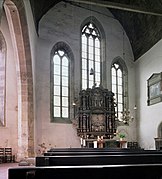
Erfurt (German pronunciation:[ˈɛʁfʊʁt] ) is the capital and largest city of the Central German state of Thuringia. It lies in the wide valley of the River Gera, in the southern part of the Thuringian Basin, north of the Thuringian Forest, and in the middle of a line of the six largest Thuringian cities, stretching from Eisenach in the west, via Gotha, Erfurt, Weimar and Jena, to Gera in the east, close to the geographic centre of Germany. Erfurt is 100 km (62 mi) south-west of Leipzig, 250 km (155 mi) north-east of Frankfurt, 300 km (186 mi) south-west of Berlin and 400 km (249 mi) north of Munich.

Jena is a city in Germany and the second largest city in Thuringia. Together with the nearby cities of Erfurt and Weimar, it forms the central metropolitan area of Thuringia with approximately 500,000 inhabitants, while the city itself has a population of about 110,000. Jena is a centre of education and research; the university was founded in 1558 and had 18,000 students in 2017 and the Ernst-Abbe-Fachhochschule Jena counts another 5,000 students. Furthermore, there are many institutes of the leading German research societies.
The Evangelical Lutheran Church in Thuringia was a Lutheran member church of the umbrella Protestant Church in Germany. The seat of the church was in Eisenach. The church covered those parts of the state of Thuringia that were not part of the former Province of Saxony. It was the largest Protestant denomination in this area.

Mühlhausen is a town in the north-west of Thuringia, Germany, 5 km north of Niederdorla, the country's geographical centre, 50 km north-west of Erfurt, 65 km east of Kassel and 50 km south-east of Göttingen.
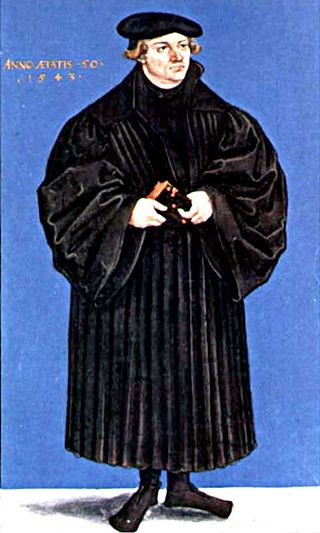
Justus Jonas, the Elder, or simply Justus Jonas, was a German Lutheran theologian and reformer. He was a Jurist, Professor and Hymn writer. He is best known for his translations of the writings of Martin Luther and Philipp Melanchthon. He accompanied Martin Luther in his final moments.

The Prussian Union of Churches was a major Protestant church body which emerged in 1817 from a series of decrees by Frederick William III of Prussia that united both Lutheran and Reformed denominations in Prussia. Although not the first of its kind, the Prussian Union was the first to occur in a major German state.
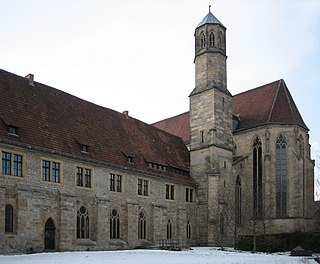
The Predigerkirche is a Lutheran church in Erfurt, central Germany. It is a monastic church to the Dominican friary, Predigerkloster, adjacent to the church. The name of the Preachers' Church derives from the designation of the Dominicans as "Preacher Brothers". The Predigerkirche was originally built by the Dominican Order in the 13th century, when the mystic Meister Eckhart was prior here. The original building was modified in 1340–50, and the bell tower was built between 1447 and 1488. The church became Protestant after the Reformation. Around 1806, the Predigerkirche was used as a prisoner-of-war camp, which led to damage to the interior and the equipment. Repairs were made around 1826.

The church of St Peter and Paul in Weimar, Germany, is also known as Herderkirche after Johann Gottfried Herder. It is the most important church building of the town, and is called Stadtkirche, opposed to the courtly Schloßkirche. It has been the church of a Lutheran parish since 1525, after the Reformation. The church is part of the World Heritage Site Classical Weimar, together with other sites affiliated with the Weimar Classicism movement. Inscribed on the World Heritage List in 1998, these sites bear testimony to the cultural importance of Weimar during the late 18th and 19th centuries and the outstanding architecture that arose in response to the cultural values of the time.

St. Augustine's Monastery in Erfurt, central Germany, is a former church and monastery complex dating from the 13th century. The site is almost one hectare in size. It was built by Augustinian friars, an order of the Catholic Church. It is most well known as the former home of Martin Luther (1483–1546), the father of the Reformation, who lived there as a friar from 1505 until 1511.
Johannes Schäfer was a German organist. He became known above all for his concerts and his work as an organ teacher.

The Reglerkirche is a church building in the historical centre of Erfurt in Thuringia, Germany. It serves a Lutheran parish as a place of worship and is one of the larger churches in the city's old part. In times of East Germany, it was considered a centre of church music in Erfurt.
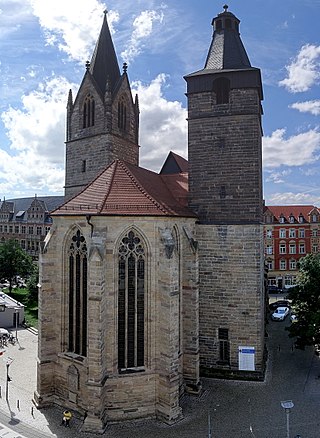
The Kaufmannskirche is a church building in the historical centre of the city of Erfurt in Thuringia, Germany. It is located at the north end of Erfurt's Anger square and has been Lutheran since 1521.
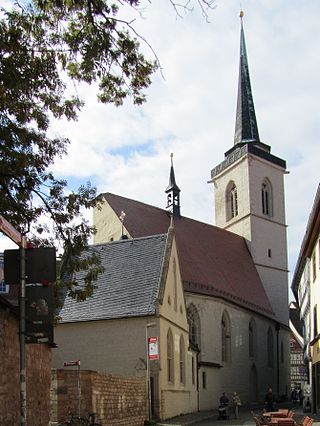
All Saints' Church in the city of Erfurt in Thuringia, Germany, is a small Roman Catholic church building dating from the 12th to 14th century. The Gothic hall church is located at the fork of Allerheiligenstraße and Marktstraße in the historical centre of Erfurt. It has an irregular floor plan and, at 53 metres, the highest church tower in the old part of the city. Since 2007, it has been the first Roman Catholic church in central Germany to house a columbarium.

St Andrew's Church is a Gothic church building at Andreasstraße in the historical centre of the city of Erfurt in Thuringia, Germany. The surrounding quarter Andreasviertel and the northern district Andreasvorstadt are named after it. St Andrew's Church is now a Lutheran parish church.

St Severus' Church in the city of Erfurt in Thuringia, Germany, is a Roman Catholic church building. It stands on the Domberg directly next to St Mary's Cathedral. As a unique architectural ensemble, both churches together form the city's landmark. Due to its unusual form, which seems to anticipate the late Gothic hall church, St Severus' Church is one of the most important Gothic buildings in Germany. The bones of the church patron Severus of Ravenna rest in an artistically very significant sarcophagus.

St Lawrence's Church in the city of Erfurt in Thuringia, Germany, is a Roman Catholic parish church dating from around 1300. The Gothic hall church is located on the northern edge of Anger square and at the beginning of the Schlösserstraße in the centre of the historical part of Erfurt.

The St.-Jakobus-Kirche in the historical centre of Ilmenau, Thuringia, Germany, is a Lutheran parish church. The Ilmenau parish belongs to the Arnstadt-Ilmenau district of the Protestant Church in Central Germany. Colloquially, the St.-Jakobus-Kirche is called the Stadtkirche for short. It houses the largest Romantic church organ in the state of Thuringia.
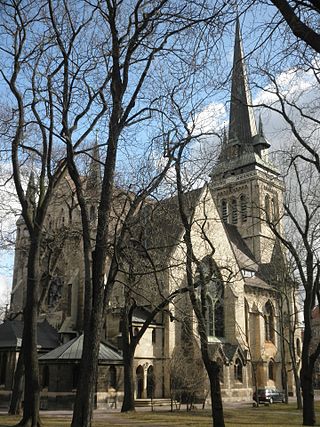
St Thomas' Church in the city of Erfurt in Thuringia, Germany, is a United Protestant parish church. It was built in Gothic Revival style in a park on Schillerstraße in the Löbervorstadt district in 1900–1902 to replace the Old St Thomas' Church, which had become too small. It has the second-highest steeple in the city at 72 metres (236 ft) and houses a Gothic altar retable from 1445, which is one of Erfurt's four valuable carved altars.

The Barfüßerkirche in the historical city centre of Erfurt in Thuringia, Germany, belonged to the most important church buildings of the city and was one of the most elaborate mendicant churches in Germany until its extensive destruction by bombing in 1944. It was mainly built in the 14th century as a monastery church of the Franciscans, who were also called Barfüßer. The choir was restored in the 1950s; beside the nave's ruin, it is situated west of the Schlösserbrücke bridge on the right bank of the Breitstrom, a branch of the Gera river.

St Bartholomew's Church in the historical city centre of Erfurt in Thuringia, Germany, was a Gothic church building at the western Anger square. Today, only its tower, the Bartholomäusturm, remains; since 1979, it has been housing a carillon.



